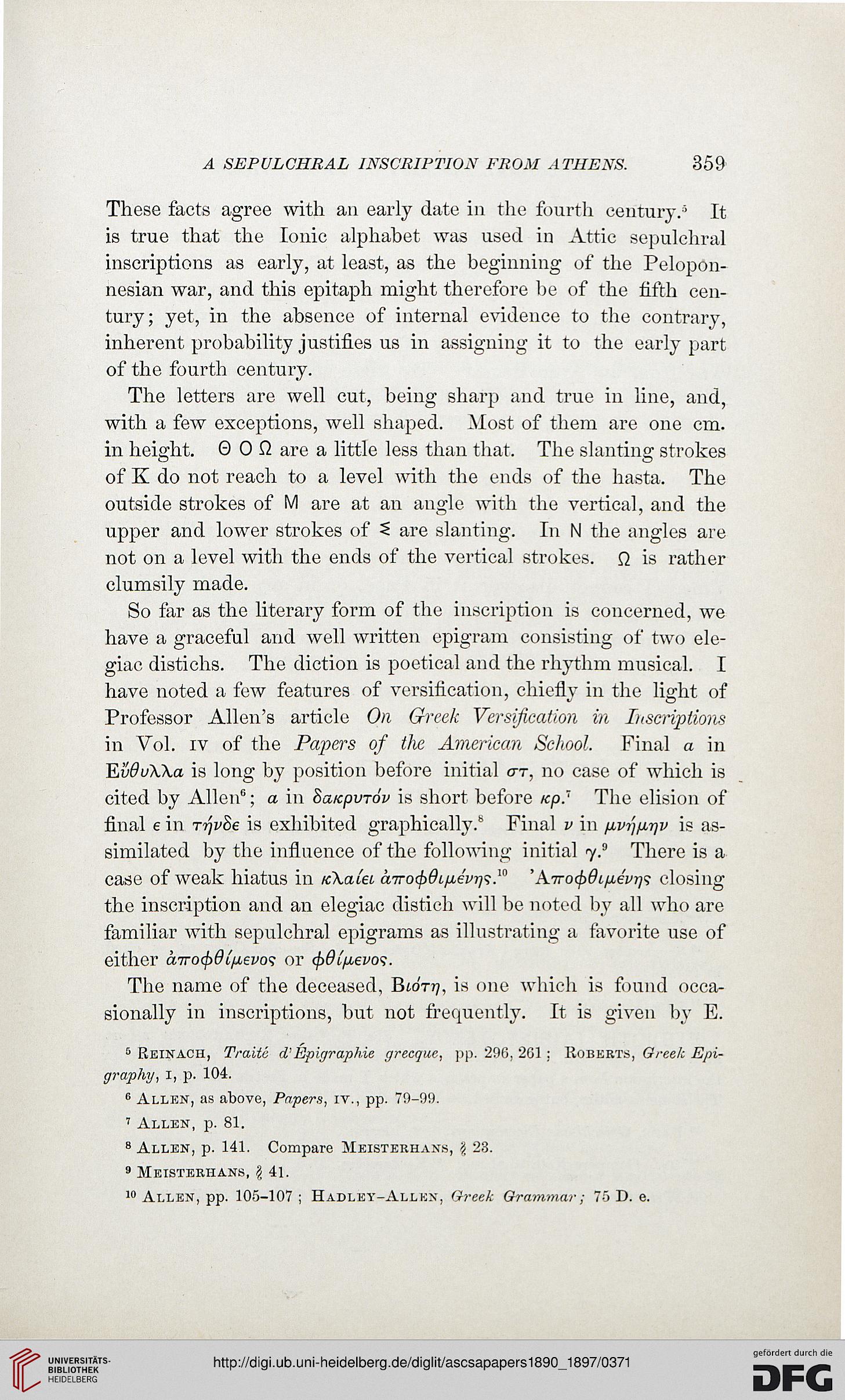A SEPULCHRAL INSCRIPTION FROM ATHENS.
359
These facts agree with an early date in the fourth century."' It
is true that the Ionic alphabet was used in Attic sepulchral
inscriptions as early, at least, as the beginning of the Pelopon-
nesian war, and this epitaph might therefore be of the fifth cen-
tury; yet, in the absence of internal evidence to the contrary,
inherent probability justifies us in assigning it to the early part
of the fourth century.
The letters are well cut, being sharp and true in line, and,
with a few exceptions, well shaped. Most of them are one cm.
in height. 0 0 Q. are a little less than that. The slanting strokes
of K do not reach to a level with the ends of the hasta. The
outside strokes of M are at an angle with the vertical, and the
upper and lower strokes of § are slanting. In N the angles are
not on a level with the ends of the vertical strokes. Q is rather
clumsily made.
So far as the literary form of the inscription is concerned, we
have a graceful and well written epigram consisting of two ele-
giac distichs. The diction is poetical and the rhythm musical. I
have noted a few features of versification, chiefly in the light of
Professor Allen's article On Greek Versification in Liscriptions
in Vol. iv of the Papers of the American School. Final a in
EvduWa is long by position before initial err, no case of which is
cited by Allen6; a in Sa/epvTov is short before icp.~ The elision of
final e in rr/vSe is exhibited graphically.6 Final v in fivij^x-qv is as-
similated by the influence of the following initial y.'J There is a
case of weak hiatus in /cXaiei cnro(f>9ifj,eur]^.w 'AirocfrOifievris closing
the inscription and an elegiac distich will be noted by all who are
familiar with sepulchral epigrams as illustrating a favorite use of
either aTro^Olixevo^ or <f)9(fj,evos.
The name of the deceased, Biorn, is one which is found occa-
sionally in inscriptions, but not frequently. It is given by E.
0 Reinacii, Traite d'Epigraphie grecque, pp. 296, 201 : Roberts, Oreek Epi-
graphy, i, p. 104.
6 Allen, as above, Papers, IT., pp. 79-99.
7 Allen, p. 81.
8 Allen, p. 141. Compare Meisterhans, ji 23.
9 Meisteriians, g 41.
10 Allen, pp. 105-107 ; Hadley-Allkn, Greek Grammar; 75 D. e.
359
These facts agree with an early date in the fourth century."' It
is true that the Ionic alphabet was used in Attic sepulchral
inscriptions as early, at least, as the beginning of the Pelopon-
nesian war, and this epitaph might therefore be of the fifth cen-
tury; yet, in the absence of internal evidence to the contrary,
inherent probability justifies us in assigning it to the early part
of the fourth century.
The letters are well cut, being sharp and true in line, and,
with a few exceptions, well shaped. Most of them are one cm.
in height. 0 0 Q. are a little less than that. The slanting strokes
of K do not reach to a level with the ends of the hasta. The
outside strokes of M are at an angle with the vertical, and the
upper and lower strokes of § are slanting. In N the angles are
not on a level with the ends of the vertical strokes. Q is rather
clumsily made.
So far as the literary form of the inscription is concerned, we
have a graceful and well written epigram consisting of two ele-
giac distichs. The diction is poetical and the rhythm musical. I
have noted a few features of versification, chiefly in the light of
Professor Allen's article On Greek Versification in Liscriptions
in Vol. iv of the Papers of the American School. Final a in
EvduWa is long by position before initial err, no case of which is
cited by Allen6; a in Sa/epvTov is short before icp.~ The elision of
final e in rr/vSe is exhibited graphically.6 Final v in fivij^x-qv is as-
similated by the influence of the following initial y.'J There is a
case of weak hiatus in /cXaiei cnro(f>9ifj,eur]^.w 'AirocfrOifievris closing
the inscription and an elegiac distich will be noted by all who are
familiar with sepulchral epigrams as illustrating a favorite use of
either aTro^Olixevo^ or <f)9(fj,evos.
The name of the deceased, Biorn, is one which is found occa-
sionally in inscriptions, but not frequently. It is given by E.
0 Reinacii, Traite d'Epigraphie grecque, pp. 296, 201 : Roberts, Oreek Epi-
graphy, i, p. 104.
6 Allen, as above, Papers, IT., pp. 79-99.
7 Allen, p. 81.
8 Allen, p. 141. Compare Meisterhans, ji 23.
9 Meisteriians, g 41.
10 Allen, pp. 105-107 ; Hadley-Allkn, Greek Grammar; 75 D. e.




